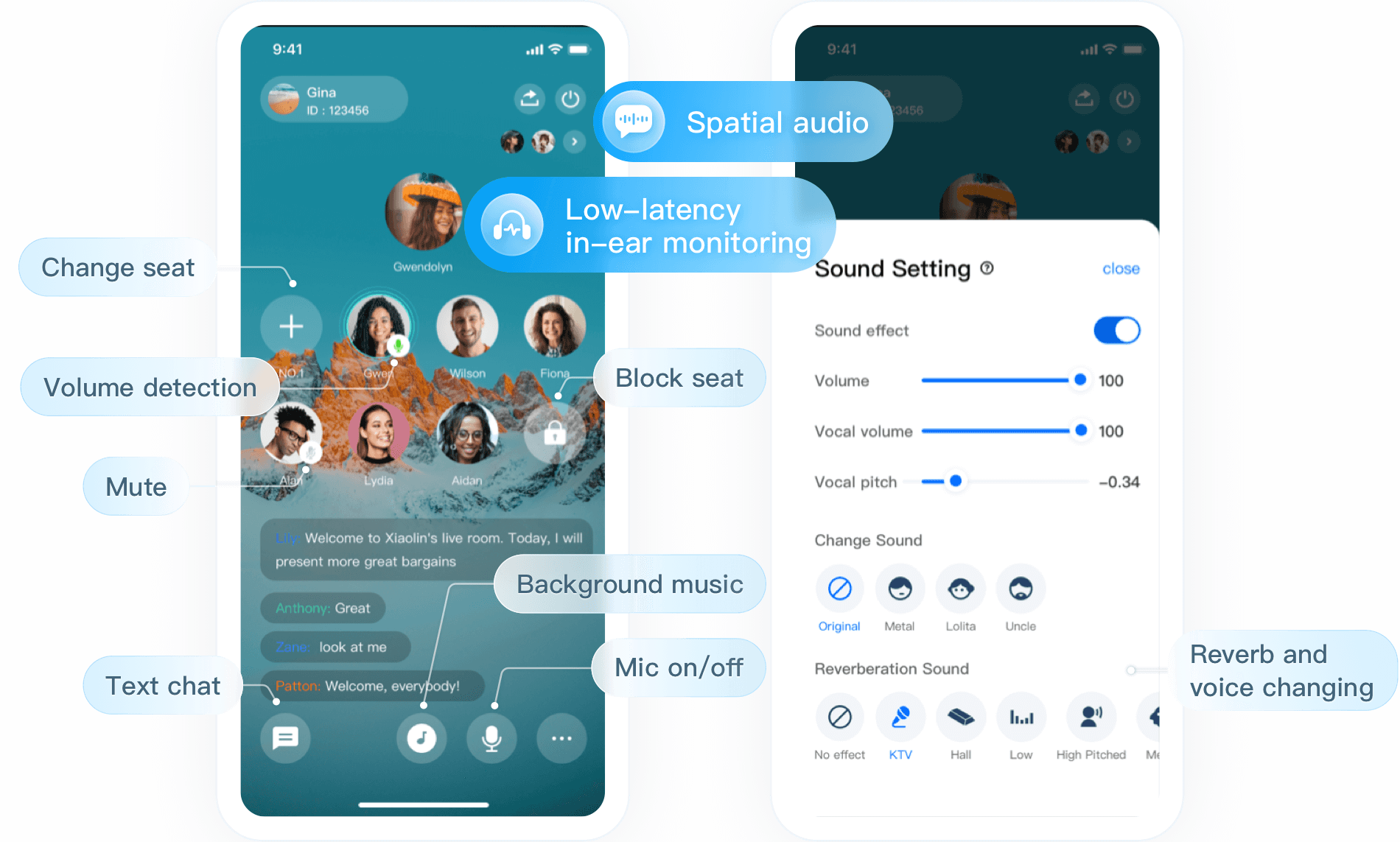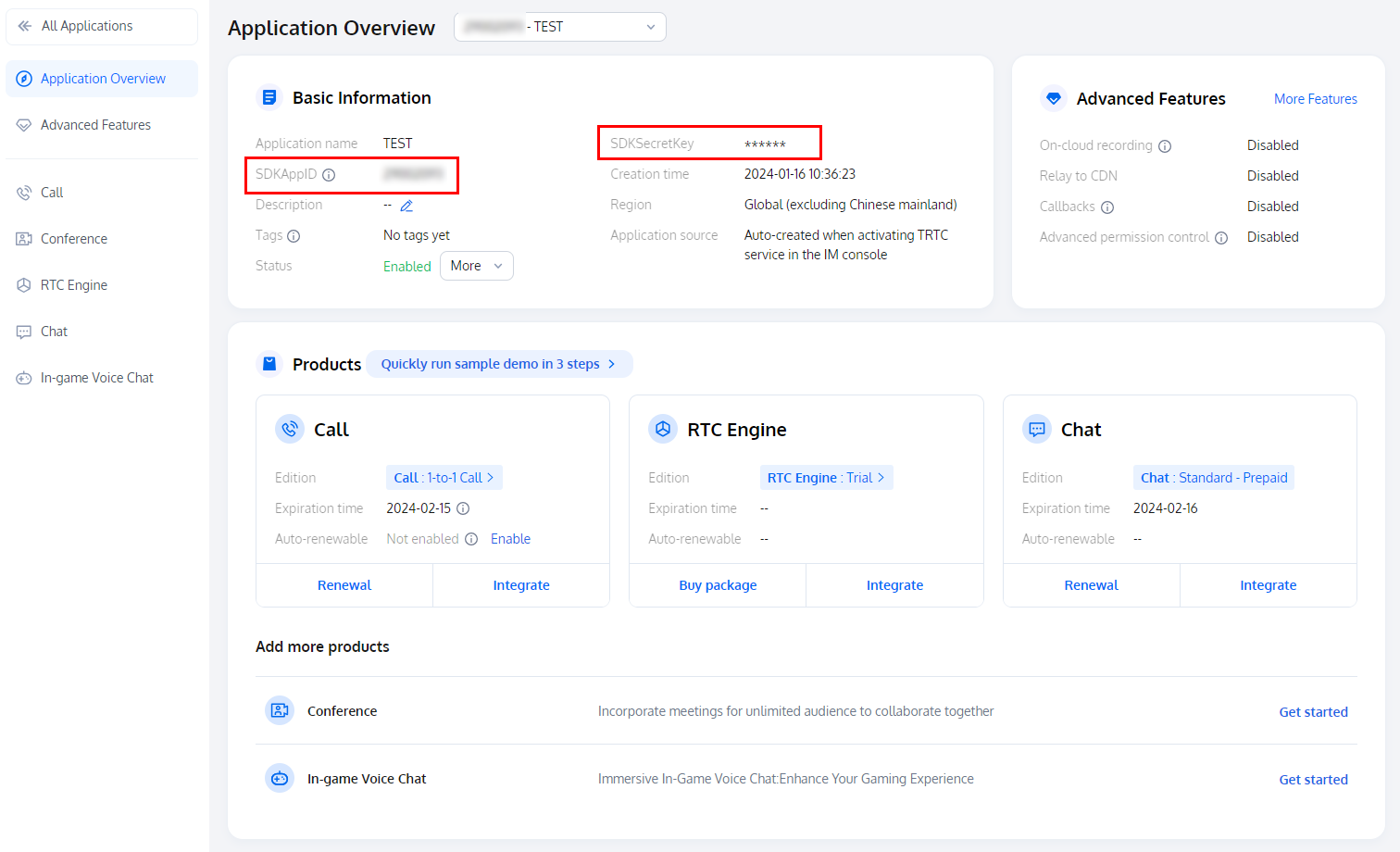Tencent Real-Time Communication
- Release Notes and Announcements
- Product Introduction
- Purchase Guide
- Monthly subscription
- Monthly Packages
- Pay-as-you-go
- Refund Instructions
- Video Calling (Including UI)
- Run Demo(TUICallKit)
- Integration (TUICallKit)
- Calls integration to Chat (TUICallKit)
- Offline Call Push (TUICallKit)
- Flutter
- Additional Features(TUICallKit)
- Multi-Person Call
- Floating Window
- Beauty Effects
- Custom Ringtone
- Monitoring Call Status
- Language Settings
- Solution (TUICallKit)
- Server APIs (TUICallKit)
- REST API
- Third-Party Callback
- Callback Configuration
- Legacy Documentation
- Call Status Callback
- Client APIs (TUICallKit)
- uniapp(Android&iOS)
- Release Notes (TUICallKit)
- FAQs(TUICallKit)
- Multi-Participant Conference (with UI)
- Run Demo(TUIRoomKit)
- Integration(TUIRoomKit)
- Screen Sharing (TUIRoomKit)
- Schedule a meeting (TUIRoomKit)
- In-meeting Call (TUIRoomKit)
- Virtual Background (TUIRoomKit)
- Conference Control (TUIRoomKit)
- In-Conference Chat (TUIRoomKit)
- Enhanced Features (TUIRoomKit)
- Text Watermark
- Client APIs (TUIRoomKit)
- iOS&Mac
- Android
- Electron
- Flutter
- RoomEngine API
- Server APIs (TUIRoomKit)
- REST API
- User Management
- Third-Party Callback
- Callback Configuration
- User Related
- Seat Connection Related
- Live Streaming (Including UI)
- Customizable Interface (TUILiveKit)
- Client APIs (TUILiveKit)
- Android
- UIKit API
- iOS
- UIKit API
- Web
- Electron
- Flutter
- API-Example
- Video Live(LiveStreamCore)
- Server APIs (TUILiveKit)
- REST API
- Room Related
- User-Related Matters
- Battle Related
- Third-Party Callback
- Callback Configuration
- User Related
- Seat Connection Related
- Voice Chat Room (with UI)
- Client APIs (TUICallKit)
- Android
- UIKit API
- iOS
- UIKit API
- Flutter
- UIKit API
- API-Example
- Server APIs (TUILiveKit)
- REST API
- Room Related
- Integration (No UI)
- SDK Download
- API Usage Guidelines
- SDK Quick Start
- 01. Importing the SDK
- 02. Entering a Room
- 03. Subscribing to Audio/Video Streams
- 04. Publishing Audio/Video Streams
- 05. Exiting a Room
- 06. Advanced Guide
- Sensing Network Quality
- Setting Video Quality
- Rotating Videos
- API Reference Manual
- iOS and macOS
- Android
- All Platforms (C++)
- Electron
- Flutter
- Unity
- React Native
- Advanced Features
- Utilizing Beautification Effects
- Testing Hardware Devices
- Testing Network Quality
- Custom Capturing and Rendering
- Custom Audio Capturing and Playback
- Event Callbacks
- Enable Watermark
- Server APIs
- Room Management APIs
- Stream mixing and relay APIs
- Data Monitoring APIs
- Pull stream Relay Related interface
- AI Transcription APIs
- Making API Requests
- Call Quality Monitoring APIs
- On-cloud recording APIs
- Usage Statistics APIs
- Appendix
- Console Guide
- Application Management
- Monitoring Dashboard
- Development Assistance
- Solution
- Real-Time Chorus
- Solution Overview (TUIKaraoke)
- TUIKaraoke APIs
- FAQs
- Legacy Documentation
- Protocols and Policies
DocumentationTencent Real-Time Communication
Integrating TUIVoiceRoom (iOS)
Last updated: 2024-09-14 16:47:24
Integrating TUIVoiceRoom (iOS)
Last updated: 2024-09-14 16:47:24
Note:
The TUIVoiceRoom component has been discontinued. If your business scenario requires integrating voice chat functionality, you can use the new version of the voice chat room (including UI) called TUILiveKit.
Overview
TUIVoiceRoom is an open-source audio/video UI component. After integrating it into your project, you can make your application support the group audio chat scenario simply by writing a few lines of code. It also supports the Android platform. Its basic features are as shown below:Note:
 |
Integration
Step 1. Download and import the TUIVoiceRoom component
Create the
TUIVoiceRoom folder at the same level as the Podfile in your Xcode project, copy TXAppBasic, Resources, Source, and TUIVoiceRoom.podspec files from the iOS directory in the GitHub repository to the folder, and complete the following import operations:Open the project's
Podfile and import TUIVocieRoom.podspec as follows:# `path` is the path of `TXAppBasic.podspec` relative to the `Podfile`pod 'TXAppBasic', :path => "TUIVoiceRoom/TXAppBasic/"# `path` is the path of `TUIVoiceRoom.podspec` relative to the `Podfile`pod 'TUIVoiceRoom', :path => "TUIVoiceRoom/", :subspecs => ["TRTC"]
Open Terminal, enter the directory of
Podfile, and run pod install.pod install
Step 2. Configure permission requests and obfuscation rules
In
info.plist, add Privacy > Microphone Usage Description to request mic access.<key>NSMicrophoneUsageDescription</key><string>`VoiceRoomApp` needs to access your mic to be able to shoot videos with audio.</string>
Step 3. Initialize and log in to the component
// Initialize TUIKitlet mTRTCVoiceRoom = TRTCVoiceRoom.shared()// Log inmTRTCVoiceRoom.login(sdkAppID: SDKAppID, userId: userId, userSig: userSig) { code, message inif code == 0 {// Logged in}}
Parameter description:
SDKAppID: The TRTC application ID. If you haven't activated TRTC, log in to the TRTC console, create a TRTC application, click Application Info, 
SDKAppID information is as shown in the figure below:

SDKSecretkey: The TRTC application key. Each secret key corresponds to a
SDKAppID. The SecretKey information is shown in the above figure.userId: The ID of the current user, which is a string that can contain only letters (a-z and A-Z), digits (0-9), hyphens (-), and underscores (_). We recommend that you keep it consistent with your user account system.
userSig: The security protection signature calculated based on
SDKAppID, userId, and Secretkey. You can click here to directly generate a debugging userSig online. For more information, see UserSig.Step 4. Implement the audio chat room
1. The room owner creates an audio chat room through TRTCVoiceRoom#createRoom.
// Initialize the audio chat room parameterslet roomParam = VoiceRoomParam()roomParam.roomName = "Room name"roomParam.needRequest = false // Whether the room owner’s permission is required for listeners to speakroomParam.coverUrl = "URL of room cover image"roomParam.seatCount = 7 // Number of room seats. In this example, the number is 7. 6 seats are available after you take one.roomParam.seatInfoList = []// Initialize the seat informationfor _ in 0..< param.seatCount {let seatInfo = VoiceRoomSeatInfo()param.seatInfoList.append(seatInfo)}// Create a roommTRTCVoiceRoom.createRoom(roomID: yourRoomID, roomParam: roomParam) { (code, message) inif code == 0 {// Group created successfully}}
2. A listener enters the audio chat room through TRTCVoiceRoom#enterRoom.
// 1. A listener calls an API to enter the roommTRTCVoiceRoom.enterRoom(roomID: roomID) { (code, message) in// Callback of the room entry resultif code == 0 {// Entered room successfully}}
3. A listener mics on through TRTCVoiceRoom#enterSeat.
// 1. A listener calls an API to mic onlet seatIndex = 2; // Seat indexmTRTCVoiceRoom.enterSeat(seatIndex: 2) { (code, message) inif code == 0 {// Mic turned on successfully}}// 2. The `onSeatListChange` callback is received, and the seat list is refreshed@Overridefunc onSeatListChange(seatInfoList: [VoiceRoomSeatInfo]) {// Refreshed seat list}
4. The room owner makes a listener speaker through TRTCVoiceRoom#pickSeat.
// 1. The room owner makes a listener a speakerlet seatIndex = 2; // Seat indexlet userId = "123"; // ID of the user to speakmTRTCVoiceRoom.pickSeat(seatIndex: 1, userId: "123") { (code, message) inif code == 0 {}}// 2. The `onSeatListChange` callback is received, and the seat list is refreshedfunc onSeatListChange(seatInfoList: [VoiceRoomSeatInfo]) {// Refreshed seat list}
5. A listener requests to speak through TRTCVoiceRoom#sendInvitation.
// Listener// 1. A listener calls an API to request to speaklet seatIndex = "1"; // Seat indexlet userId = "123"; // User IDlet inviteId = mTRTCVoiceRoom.sendInvitation(cmd: "takeSeat", userId: ownerUserId, content: "1") { (code, message) in// Callback of the result}// 2. Place the user in the seat after the invitation is acceptedfunc onInviteeAccepted(identifier: String, invitee: String) {if identifier == selfID {self.mTRTCVoiceRoom.enterSeat(seatIndex: ) { (code, message) in// Callback of the result}}}// Room owner// 1. The room owner receives the requestfunc onReceiveNewInvitation(identifier: String, inviter: String, cmd: String, content: String) {if cmd == "takeSeat" {// 2. The room owner accepts the requestself.mTRTCVoiceRoom.acceptInvitation(identifier: identifier, callback: nil)}}
6. The room owner invites a listener to speak through TRTCVoiceRoom#sendInvitation.
// Room owner// 1. Call `sendInvitation` to invite user `123` to take seat 2let inviteId = self.mTRTCVoiceRoom.sendInvitation(cmd: "pickSeat", userId: ownerUserId, content: "2") { (code, message) in// Callback of the result}// 2. Place the user in the seat after the invitation is acceptedfunc onInviteeAccepted(identifier: String, invitee: String) {if identifier == selfID {self.mTRTCVoiceRoom.pickSeat(seatIndex: ) { (code, message) in// Callback of the result}}}// Listener// 1. The listener receives the invitationfunc onReceiveNewInvitation(identifier: String, inviter: String, cmd: String, content: String) {if cmd == "pickSeat" {// 2. The listener accepts the invitationself.mTRTCVoiceRoom.acceptInvitation(identifier: identifier, callback: nil)}}
7. Implement text chat through TRTCVoiceRoom#sendRoomTextMsg.
// Sender: Sends text chat messagesself.mTRTCVoiceRoom.sendRoomTextMsg(message: message) { (code, message) in}// Receiver: Listens for text chat messagesfunc onRecvRoomTextMsg(message: String, userInfo: VoiceRoomUserInfo) {// Handling of the messages received}
8. Implement on-screen commenting through TRTCVoiceRoom#sendRoomCustomMsg.
// For example, a sender can customize commands to distinguish on-screen comments and likes.// For example, use "CMD_DANMU" to indicate on-screen comments and "CMD_LIKE" to indicate likes.self.mTRTCVoiceRoom.sendRoomCustomMsg(cmd: "CMD_DANMU", message: "hello world", callback: nil)self.mTRTCVoiceRoom.sendRoomCustomMsg(cmd: "CMD_LIKE", message: "", callback: nil)// Receiver: Listens for custom messagesfunc onRecvRoomCustomMsg(cmd: String, message: String, userInfo: VoiceRoomUserInfo) {if cmd == "CMD_DANMU" {// An on-screen comment is received}if cmd == "CMD_LIKE" {// A like is received}}
Suggestions and Feedback
If you have any questions or encounter any issues related to Tencent RTC, we encourage you to post your questions on our Stackoverflow community forum or Telegram group. Our team and other community members are on standby to help you.
Was this page helpful?
You can also Contact Sales or Submit a Ticket for help.
Yes
No
